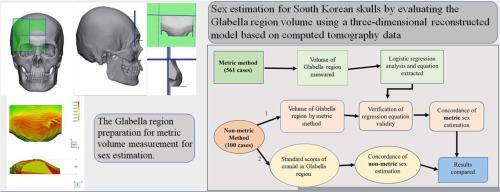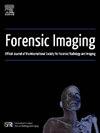Validation of walker's non-metric sex estimation method using 3D glabella images in Koreans: A metric approach
IF 1
Q4 RADIOLOGY, NUCLEAR MEDICINE & MEDICAL IMAGING
引用次数: 0
Abstract
Computed tomography (CT) is excellent for examining the skull and providing a contiguous series of cross-sections and three-dimensional information. We aimed to develop a forensic anthropological method for determining sex in Koreans, involving a metric analysis of the glabellar region volume derived from three-dimensional CT images of the skull. A total of 661 CT images of Korean skulls were obtained. Of these, 100 CT images were randomly selected for non-metric sex estimation using the Walker method, and the remaining 561 CT images were used to derive a regression equation for sex estimation in Koreans using the metric method. To verify the validity of the derived equation, we analyzed 100 CT images previously selected for non-metric sex estimation using the metric method. The glabellar region volume was greater in males than in females. Moreover, measuring the glabellar region volume using the metric method increased sex estimation accuracy by 5 % compared to the non-metric method. We elucidated a new measurement range and method for measuring the glabellar region volume. The sex matching rate of the metric method was similar (81 %) to that reported in a previous study that used a non-metric method. In summary, we quantitatively discriminated sex using three-dimensional measurements of the glabellar region and demonstrated that the non-metric sex estimation method based on skull data of the non-Korean population is not suitable for estimating sex using the glabella in Koreans. The metric method proposed in this study will increase the accuracy and reliability of sex estimation in Koreans.

验证沃克的非度量性别估计方法使用韩国人的三维眉间图像:一个度量方法
计算机断层扫描(CT)非常适合检查颅骨,并提供连续的一系列横截面和三维信息。我们的目标是开发一种法医人类学方法来确定韩国人的性别,包括从头骨的三维CT图像中获得的额骨区域体积的度量分析。共获得韩国人颅骨CT图像661张。其中,随机选择100张CT图像使用Walker方法进行非度量性性别估计,其余561张CT图像使用度量性方法推导韩国人性别估计的回归方程。为了验证推导方程的有效性,我们分析了之前选择的100张CT图像,使用度量方法进行非度量性别估计。男性的眉间区体积大于女性。此外,与非度量方法相比,使用度量方法测量眉间区域体积可使性别估计精度提高5%。我们提出了一种新的测量眉间区体积的测量范围和方法。公制方法的性别匹配率与先前使用非公制方法的研究报告相似(81%)。综上所述,我们使用眉间区域的三维测量来定量区分性别,并证明基于非韩国人口头骨数据的非度量性别估计方法不适合使用眉间来估计韩国人的性别。本研究提出的度量方法将提高韩国人性别估计的准确性和可靠性。
本文章由计算机程序翻译,如有差异,请以英文原文为准。
求助全文
约1分钟内获得全文
求助全文
来源期刊

Forensic Imaging
RADIOLOGY, NUCLEAR MEDICINE & MEDICAL IMAGING-
CiteScore
2.20
自引率
27.30%
发文量
39
 求助内容:
求助内容: 应助结果提醒方式:
应助结果提醒方式:


